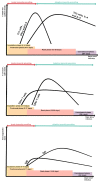Measles: An Overview of a Re-Emerging Disease in Children and Immunocompromised Patients
- PMID: 32085446
- PMCID: PMC7074809
- DOI: 10.3390/microorganisms8020276
Measles: An Overview of a Re-Emerging Disease in Children and Immunocompromised Patients
Abstract
Despite the availability of a safe and effective vaccine, in 2018, around 350,000 measles cases were reported worldwide, which resulted in an estimate of 142,300 deaths from measles. Additionally, in 2017, global measles cases spiked, causing the death of 110,000 people, mostly children under the age of 5 years and immunocompromised adults. The increase in measles incidence is caused by the ongoing reduction of vaccination coverage. This event has triggered public and scientific interest. For this reason, we reviewed the pathophysiology of measles infection, focusing on mechanisms by which the virus spreads systemically through the host organism. By reaching the lymphocytes from the airways through a "trojan horse" strategy, measles induces an immunosuppression status. H and F glycoproteins, both expressed in the envelope, ensure attachment of the virus to host cells and spreading from one cell to another by binding to several receptors, as described in detail. The severity of the disease depends both on the age and underlying conditions of patients as well as the social and health context in which epidemics spread, and is often burdened by sequelae and complications that may occur several years after infection. Particular attention was paid to special groups that are more susceptible to severe or atypical measles. An overview of microbiology, symptoms, diagnosis, prevention, and treatment completes and enriches the review.
Keywords: immunity; measles; viral–host interactions.
Conflict of interest statement
The authors declare no conflict of interest.
Figures
References
-
- Perry R.T., Halsey N.A. The clinical significance of measles: A review. J. Infect. Dis. 2004;189:S4–S16. - PubMed
Publication types
Grants and funding
LinkOut - more resources
Full Text Sources



